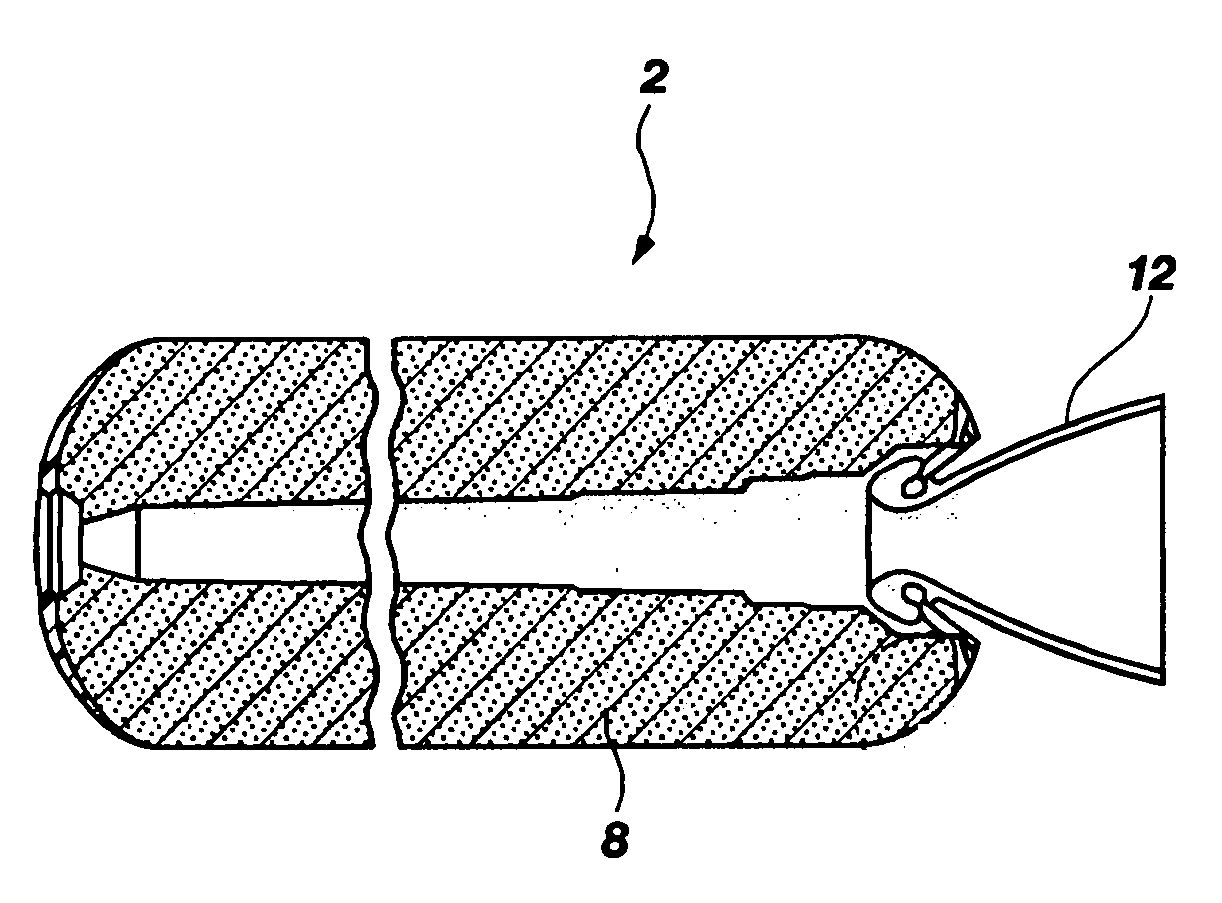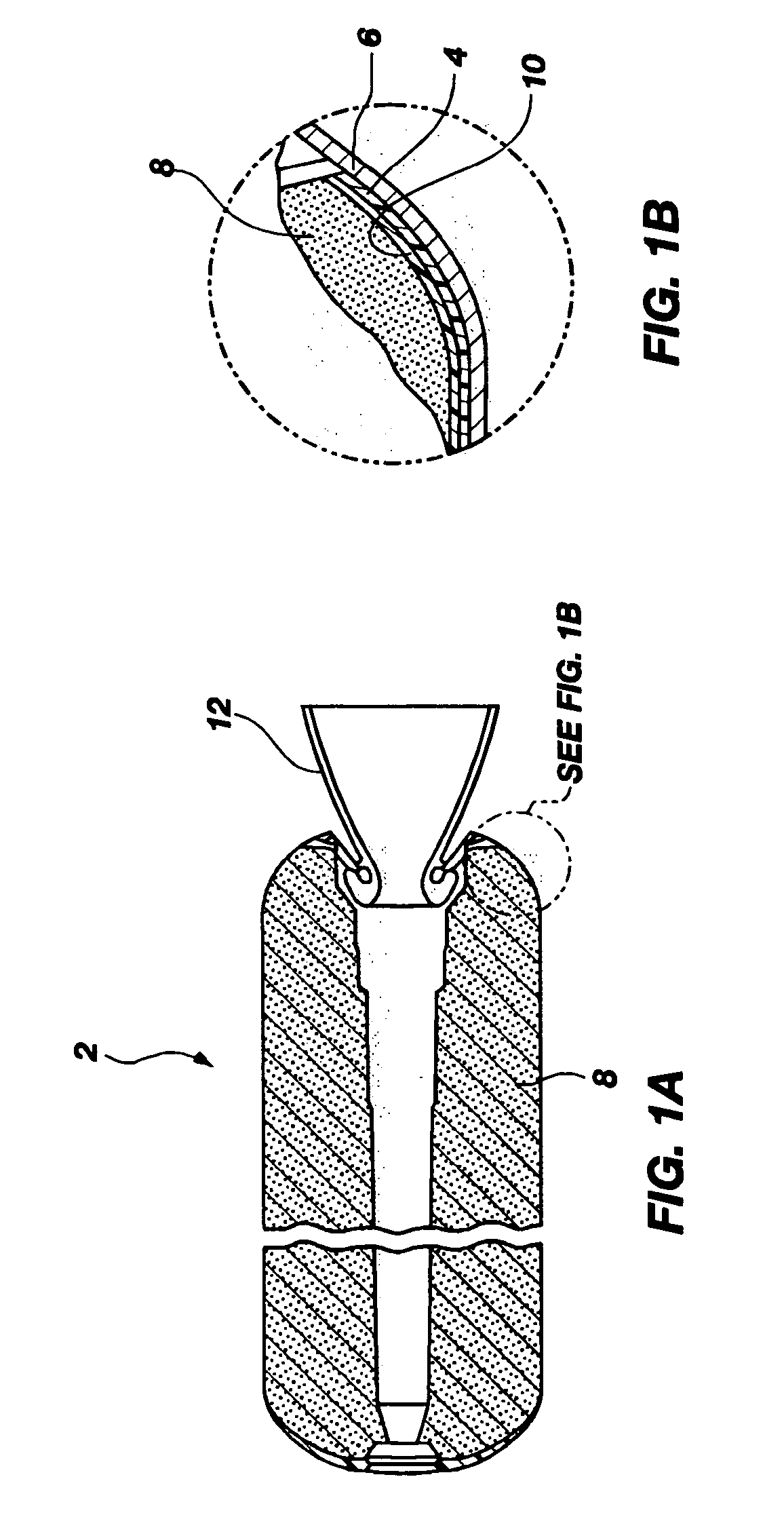Basalt fiber and nanoclay compositions, articles incorporating the same, and methods of insulating a rocket motor with the same
a technology of nanoclay and composition, applied in the field of thermoplastic insulation for use in an article or an apparatus, can solve the problems of rocket motor failure, rocket motor construction and processing of materials that are difficult to achieve, and the hostile environment is characterized by extreme high temperatures, pressures and turbulen
- Summary
- Abstract
- Description
- Claims
- Application Information
AI Technical Summary
Benefits of technology
Problems solved by technology
Method used
Image
Examples
example 1
Formulations of Insulation Compositions
[0039] Insulation compositions having the ingredients shown in Table 1 were formulated by mixing all of the ingredients, except for the cure package, to form a master batch. During mixing, the temperature of the master batch was maintained at less than or equal to approximately 310° F. The ingredients of the master batch were mixed for up to approximately 25 minutes. The temperature of the master batch was reduced to less than or equal to approximately 220° F. before adding the ingredients of the cure package, which were mixed in with the master batch for up to approximately 5 minutes. The resulting insulation compositions had a rubber-like consistency.
TABLE 1Insulation Compositions having an NBR(s) and PBI Fibers and / or Nanoclay.RDL6098RDL6099RDL7000RDL7023RDL7068RDL7069RDL7083RDL7094Ingredient(wt %)(wt %)(wt %)(wt %)(wt %)(wt %)(wt %)(wt %)Nipol ® 105226262623.3822.8518.1218.2418.24Nipol ® 104226262623.3822.8527.1927.3624.62Nipol ® 1312———...
example 2
Rheological Properties of the Insulation Compositions
[0040] The rheological properties of the insulation compositions described in Example 1 were determined by conventional techniques. The results of the rheological testing are shown in Table 2. For comparative purposes, the rheological properties of an ASNBR composition are also provided. The ASNBR composition is produced by Esterline-Kirkhill Elastomers.
TABLE 2Rheological Properties of ASNBR, RDL6098, RDL6099,RDL7000, RDL7023, RDL7069, RDL7083, and RDL7094.PropertyASNBRRDL6098RDL6099RDL7000RDL7023RDL7069RDL7083RDL7094Mooney44-8861.2262.0668.7142.6340.1741.4834.63Viscosity1 (MV)Mooney Scorch2 5-308.397.668.158.9910.5111.512.49(minutes)TC9064.7339.2636.2535.2138.134.2735.0337.23(minutes)3
1MU at 212° F.
2MS + 1 at 290° F. (as determined by ASTM D 1646)
3TC90 is the 90 percent cure time measured by ODR at 300° F. (as determined by ASTM D2084)
[0041] As shown in Table 2, the insulation compositions had similar or improved rheologica...
example 3
Physical, Mechanical, and Electrostatic Properties of the Insulation Compositions
[0042] Physical, mechanical, and electrostatic properties of the insulation compositions described in Example 1 are shown in Table 3. These properties were determined by conventional techniques. The values for the mechanical properties of RDL7069 were measured at 2″ / minute, while those for RDL6098, RDL6099, RDL7000, RDL7023, RDL7083, and RDL7094, and ASNBR were measured at 20″ / minute. For comparative purposes, the physical, mechanical, and electrostatic properties of the ASNBR composition are also shown.
TABLE 3Physical, Mechanical, and Electrostatic Properties of ASNBR, RDL6098, RDL6099, RDL7000, RDL7023, RDL7069, RDL7083, and RDL7094.PropertyASNBRRDL6098RDL6099RDL7000RDL7023RDL7069RDL7083RDL7094Density (g / cm3)11.255-1.3051.20141.18091.17871.19431.18331.191.19Shore A Hardness275-8576.479.481.569.671.271.971.4Tensile Elongation50+488153107485576482468parallel to fibers) (%)3Tensile Elongation225+51736...
PUM
| Property | Measurement | Unit |
|---|---|---|
| diameter | aaaaa | aaaaa |
| diameter | aaaaa | aaaaa |
| length | aaaaa | aaaaa |
Abstract
Description
Claims
Application Information
 Login to View More
Login to View More - R&D
- Intellectual Property
- Life Sciences
- Materials
- Tech Scout
- Unparalleled Data Quality
- Higher Quality Content
- 60% Fewer Hallucinations
Browse by: Latest US Patents, China's latest patents, Technical Efficacy Thesaurus, Application Domain, Technology Topic, Popular Technical Reports.
© 2025 PatSnap. All rights reserved.Legal|Privacy policy|Modern Slavery Act Transparency Statement|Sitemap|About US| Contact US: help@patsnap.com


